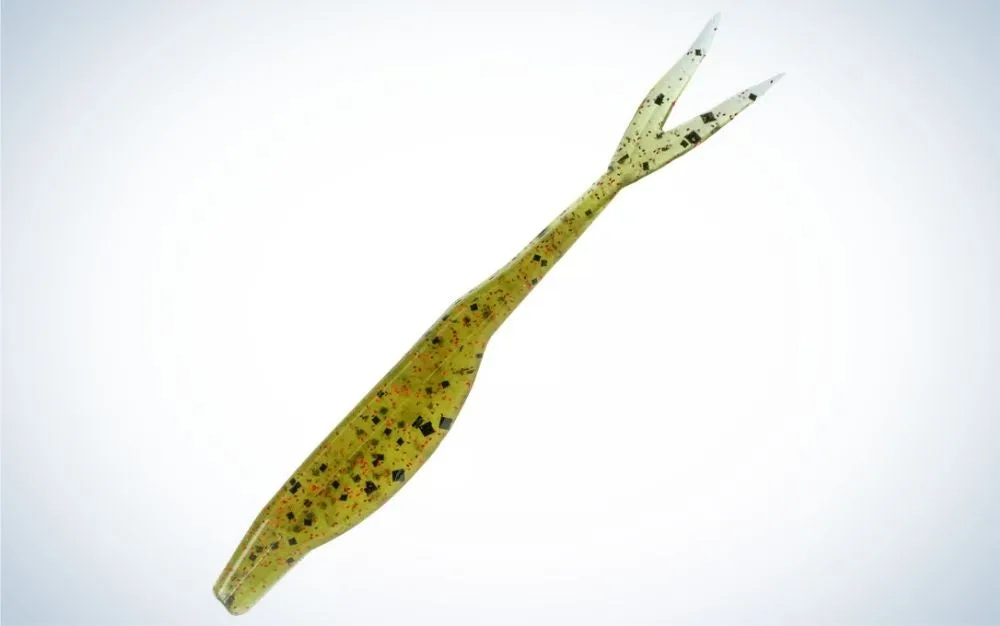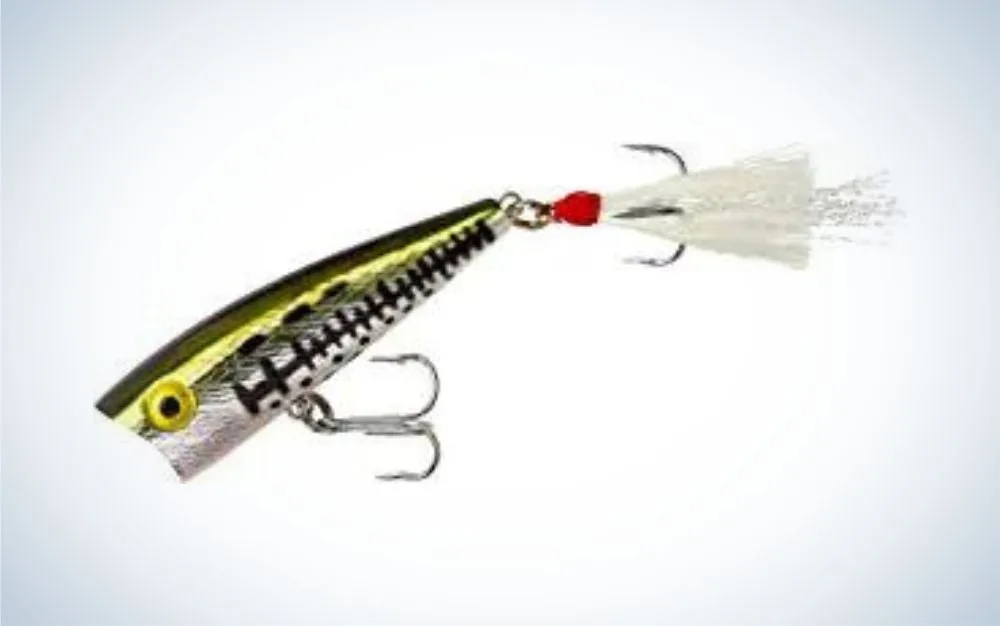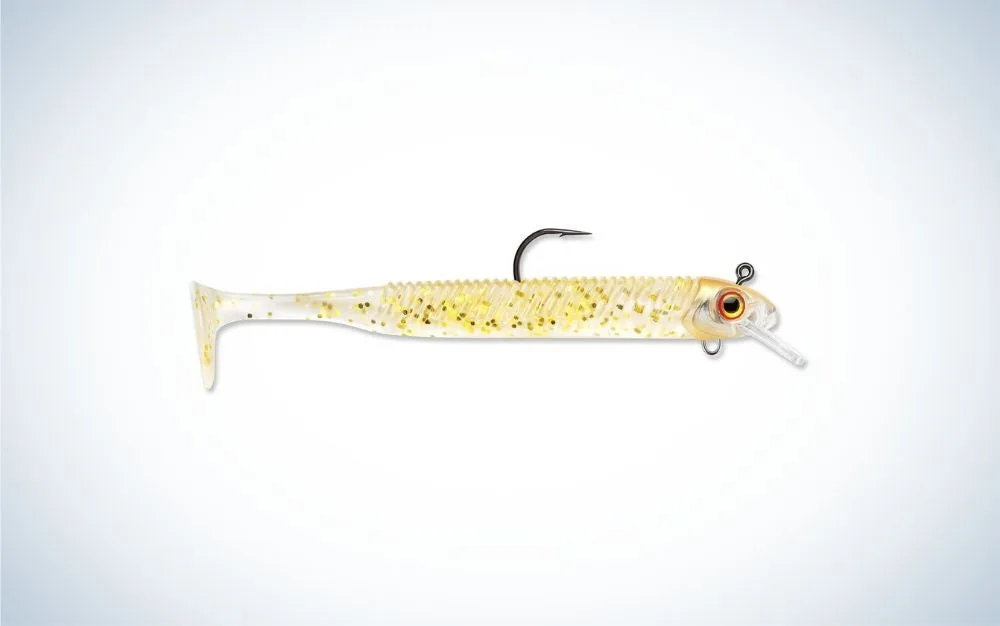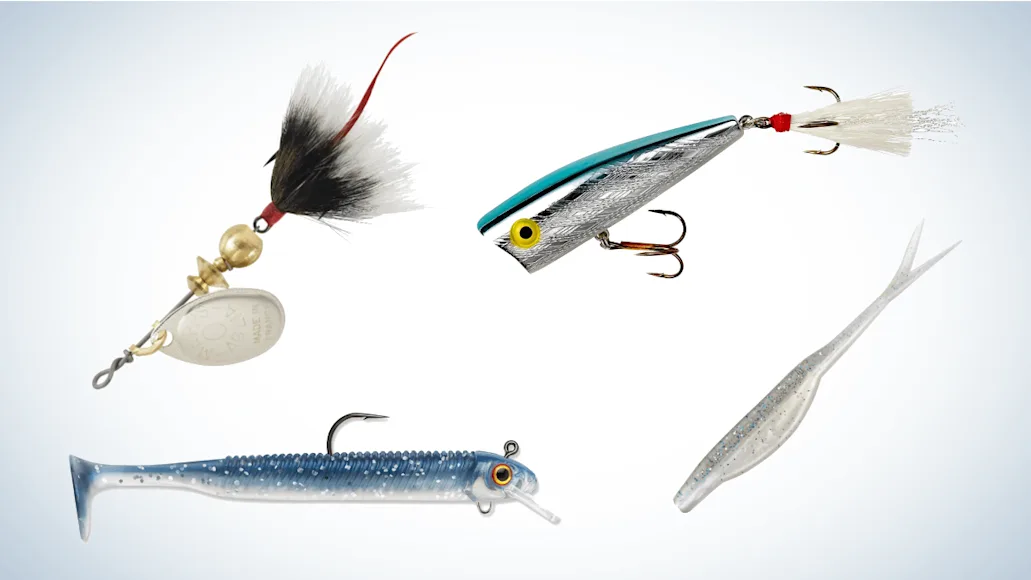_We may earn revenue from the products available on this page and participate in affiliate programs. Learn more ›
_
Best Overall

Zoom Super Fluke Jr.
LEARN MORE
Summary
The Super Fluke Jr. is versatile, affordable, durable and easy to fish. Oh yeah, and fish love it.
Best Topwater Lures

Rebel Pop-R
LEARN MORE
Summary
The Rebel Pop-R has been drawing surface strikes for over 30 years with its popping, chugging action that screams “eat me!”
Best for White Bass Runs

Mepps Aglia
LEARN MORE
Summary
A sentimental favorite, this lure just flat-out catches fish and is ideal for the tributary streams white bass run into in the spring to spawn.
Selecting lures for white bass—also known as sand bass, sandies, silver bass, or silvers—is both fun and challenging thanks to this fish’s willingness to eat a variety of baits. White bass are a migratory, open-water fish that are driven by the need to feed predominantly on baitfish such as shad and shiners. As schooling fish, where you find one eating bait, you will most certainly find more. Many white bass anglers enjoy the spring runs of these fish as they move from lakes and reservoirs up tributary streams and rivers to spawn. Following the spawn, the fish return to lakes and reservoirs and school heavily. When they locate baitfish, they pin the forage against the water’s surface, rock piles, or shorelines, making it easier to harvest the next meal.
For anglers, this informs your choice of lures, which can be tailored based on these seasonal behavior patterns. To be most effective in your angling for these feisty gamefish, here are a few of the best lures for white bass.
Best Overall – Zoom Super Fluke Jr.
Best Topwater Lures – Rebel Pop-R
Best For White Bass Runs – Mepps Aglia
Best For Schooling White Bass – Storm 360GT Searchbait
Best Overall – Zoom Super Fluke Jr.
Best Overall

Why It Made the Cut: The Super Fluke Jr. is versatile, affordable, durable and easy to fish. Oh yeah, and fish love it.
Key Features
Size(s): 4 inches
Popular Colors: White Pearl, White Ice, and Smokin’ Shad
Presentation Method(s): Weighted jighead, weedless offset hook with or without insert weights or as a trailer on small spinnerbaits
Pros
Available in nine colors spanning realistic baitfish looks from light to dark
Deep belly and forked tail design create incredible action
Belly design features a hook slot for easy rigging
Holds up to numerous predatory attacks
Cons
Only available in one size
The Super Fluke Jr. can be fished in so many ways that I think it’s close to impossible to fish it “wrong.” When white bass have bait trapped against the water’s surface, fish it unweighted with an offset hook, where you can skitter it across or near the surface like a wounded baitfish. If the near-surface presentation isn’t working, insert weights and a slow-falling retrieve will often do the trick. The deep belly and forked tail cause it to twist and corkscrew even on free fall; fish often grab the bait during the drop so watch your line for sideways motion. The good news in these situations is that fish will hold onto this bait, allowing time for a solid hookset.
If white bass are suspended in deeper water—generally with bait pinned against an underwater hump—you can use a jig head for more weight and an awesome glide and fall jigging retrieve.
Best Topwater Lures – Rebel Pop-R
Best Topwater Lures

Why It Made the Cut: The Rebel Pop-R has been drawing surface strikes for over 30 years with its popping, chugging action that screams “eat me!”
Key Features
Size(s): 2 1/2 inches
Popular Colors: Silver/Black, Silver/Blue, Foxy Shad
Presentation Method(s): Pop-n-Pause or steady retrieve with periodic pause
Pros
Popping, chugging action is exactly what you want for this type of surface presentation
Available in six colors
Dressed rear treble with glitter filament for extra flash
Cons
Not useful when white bass aren’t on the surface bite
Who doesn’t love the experience of watching an aggressive fish explode on a topwater lure? White bass often feed near the surface, using the barrier between water and air to trap schools of bait. This is an ideal scenario for a surface bite and the Rebel Pop-R is a go-to lure in this situation. The concave face is the key to this lure’s attention-getting ability. With a sharp jerk of the rod tip, the lure pushes water and gives off an audible “pop” sound. A more moderate retrieve creates a chugging commotion on the surface that often causes fish to commit. The added flash filaments in the rear hook dressing are a nice added feature; this flash tail effect draws strikes during the pause between pops.
The black over silver finish is a must-have—I have confidence in this color scheme and the proof is in the numbers of fish caught. The other color schemes are also good for mimicking various baitfish.
Best for White Bass Runs – Mepps Aglia
Best for White Bass Runs

Why It Made the Cut: A sentimental favorite, this lure just flat-out catches fish and is ideal for the tributary streams white bass run into in the spring to spawn.
Key Features
Size(s): #1 (1/8-ounce) and #2 (1/6-ounce)
Popular Colors: Silver/Red-White blade with white tail dressing and GLO White blade with gray tail dressing
Presentation Method(s): Steady retrieve is generally best; if that’s not working, try adding rod tip action and pauses
Pros
Available in 33 blade colors and 10 tail dressing colors
Six size options, from 0 to 5
Strong vibration and flash attracts fish even in stained water
Cons
Doesn’t work well in heavily vegetated areas
I won’t lie: The Mepps Aglia and I are old friends. (I might have tied on a Mepps spinner before I tied my shoelaces.) Personal bias aside, this is a great lure for throwing in streams and rivers. It’s also pretty solid in lake scenarios. But the Aglia truly shines during the spring runs when white bass find their way into tributary streams and rivers. Despite the effects of swollen flows, the incredible vibration and flash given off by these spinners gets the attention of white bass. Overall—and especially in discolored water—I prefer a steady retrieve that allows fish to find the bait. Color choice is tough but I like the GLO White and the traditional Silver Red-White, both with a dressed hook.
Best for Schooling White Bass – Storm 360GT Searchbait
Best for Schooling White Bass

Why It Made the Cut: The Storm 360GT Searchbait is a versatile bait that can be fished with various retrieves and effectively cover a lot of water to find the next school of white bass.
Key Features
Size(s): 2 1/2 inches (3/32-ounce), 3 1/2 inches (1/8-ounce), 4 1/2 inches (1/4-ounce) and 5 1/2 inches (3/8-ounce)
Popular Colors: Tru Blue, Chartreuse Ice, Pearl Ice
Presentation Method(s): Steady retrieve, jigging and alternating steady with periodic pauses for free fall
Pros
Comes with one pre-rigged bait ready to fish
Easy to rig with entrance and exit holes on the lure body
Rattling jig head with realistic finish and 3D holographic eyes
Very durable
Cons
Only three swimbait bodies per pack
The toe-in-boot tail design of the 360GT Searchbait creates a seductive wiggle that white bass and other predatory fish can’t resist. One of the beauties of this lure is its “ready to use” packaging—this was done intentionally to assist anglers new to these types of baits or fishing overall. True to its name, the Searchbait provides an excellent tool for pinpointing the location of schooling white bass. Easy to cast with incredible action and a steady retrieve, it allows you to cover water thoroughly and quickly until you get that first fish.
The pre-rigged bait also provides anglers with an example of how to properly rig the lure when it comes time to replace the body—entrance and exit holes for the hook are indicated on the lure eliminating any head scratching or trial-and-error guesswork. However, the 360GT bodies are incredibly durable, holding their own for quite a few bass before a change is needed.
The jighead included with each package is a next-level design, with built-in rattle, 3D holographic eyes, and a high quality VMC coastal black hook. I also like the fact that this bait is environmentally friendly with phthalate-free bodies. Even the trap-clam packaging is designed to be environmentally responsible.
Things to Consider Before Buying Lures for White Bass
Season
Seasonal weather patterns drive white bass behavior. Springtime means spawning runs up tributary streams and rivers. Lures that fish well in the flowing water of creeks and tributaries are ideal. As spawning is completed, white bass return to lakes for feedin in late spring and early summer, so lures that allow you to cover water in search of schools of fish are important. Early in the day, fish may be feeding near the surface, which is when you’ll want a good surface plug. As the year progresses and fish move into deeper water, look for baits that allow you to fish deep structure.
Predominant Forage
Though aggressive feeders, white bass will sometimes key to the size of the predominant forage, whether it be shad, shiners, or other types of baitfish. To be prepared, carry a selection of lures that range in size from 2 to 4 inches and in a selection of colors; white, black over silver, blue over silver, pearl and natural baitfish patterns that imitate the local forage constitute a good all-around selection. I also add a bright attractor color like chartreuse to the mix.
Presentation
Have a selection of lures that allow you to effectively fish the water column from top to bottom and with a variety of looks. These would include surface baits that simulate wounded baitfish, lures that allow you to cover water in search of white bass schools, and lures which allow you to fish rivers and streams effectively when the bass are running in the spring.
FAQs
Q: What attracts white bass?
White bass are predators and are attracted by schools of baitfish. Find the bait and you’ll find the bass.
Q: What size lures are best for white bass?
The best size for lures used to catch white bass range from 2 to 4 inches. White bass have relatively small mouths but big appetites. Soft baits can be as big as 4 inches while hard lures like crankbaits and topwaters are best at 2 to 2 1/2 inches.
Q: What colors do white bass like?
White bass are attracted to a variety of colors, which is one of the things anglers find so attractive about these great gamefish. White and pearl rank high on the list of favorites and natural color schemes often named for the suggested baitfish (Tennessee Shad) are always worthwhile. Suggestive combos like black over silver and blue over silver are must-haves in my tackle box, along with at least one chartreuse.
Final Thoughts
White bass are aggressive hard-fighting fish that travel in schools and will eat a wide variety of lures. Prolific spawners, they grow quickly and are excellent for fishermen looking to bring home some fish. When you target white bass, be sure to carry a selection of lures (check out our in-depth breakdown of the best fishing lures
). Have imitations that effectively match the local baitfish sizes, allow you to cover water while searching for schools of bass, and present various looks from top to bottom in the water column. Find the bait, find the first white bass, and then hang on for some unbelievable fun!
Methodology
My first experience with white bass occurred years ago while fishing on the St. Clair River in Ontario. After locating the school of white bass, the action was nonstop and memorable—I was hooked. Since then, I’ve augmented my knowledge of these fish with information gathered from a variety of sources: fisheries biologists, fishing guides in the Great Lakes region, and other white bass enthusiasts. In evaluating various lures, I considered the following characteristics:
Presentation method(s)
Where it fishes best in the water column
Versatility
Size
Colors





